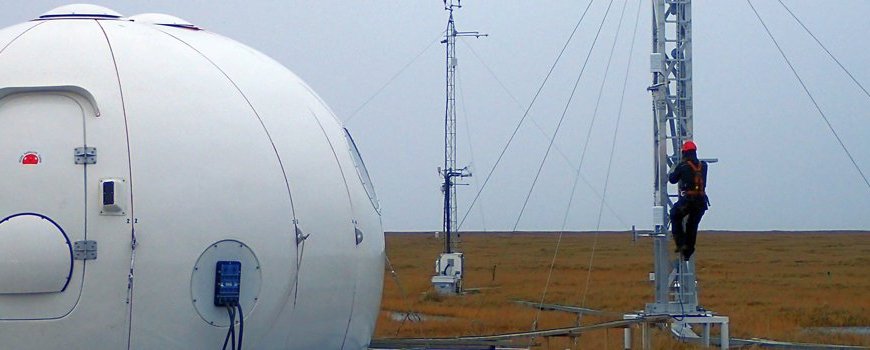Arctic regions have captured and stored carbon for tens of thousands of years, but a new study shows winter carbon emissions from the Arctic may now be putting more carbon into the atmosphere than is taken up by plants each year. The study, published today in Nature Climate Change, warns that winter carbon dioxide (CO2) loss from the world’s permafrost regions could increase by 41% if human-caused greenhouse gas emissions continue on their current pace. A team led by Torsten Sachs of GFZ German Research Centre for Geosciences contributed to the study.
“We’ve known that warmer temperatures and thawing permafrost have been accelerating winter CO2 emissions, but we haven’t had a clear accounting of the winter carbon balance,” said Sue Natali, Director of the Woods Hole Research Center’s (WHRC) Arctic Program and lead author on the study.“These results, which provide a new baseline for winter CO2 emissions from the Arctic, indicate that winter CO2 loss may already be offsetting growing season carbon uptake and these losses will increase as the climate continues to warm.”
The authors synthesized more than 1000 site-months of observed CO2 emissions from more than 100 locations across the entire northern permafrost domain. At GFZ, researchers led by Torsten Sachs contributed one of essentially just two study-sites in the vast Siberian Arctic. The greenhouse gas flux monitoring tower and associated climate stations at the Research Station Samoylov Island in the central Lena River Delta are operated jointly by GFZ, Alfred Wegener Institute for Polar and Marine Research, and the University of Hamburg.
Torsten Sachs: “The largest share of the world’s permafrost is on Russian territory – yet there are only very few continuously active study-sites monitoring GHG emissions from these vast permafrost regions.East of the Ural Mountains and north of the Arctic Circle, just two groups contributed to this study: Colleagues at MPI Jena working around Cherskiy, and us from GFZ, AWI and Hamburg working in the Lena River Delta. At the same time, we see the strongest positive trend in winter CO2 emissions under both climate scenarios in this zone of continuous permafrost, and observed emissions were [edit:] generally higher than projected by models, indicating room for improvement of both the models and our understanding of winter emissions. So these sites, even though they are remote, expensive to operate, and not always comfortable, are extremely important if we really want to understand the permafrost region’s contribution to changes in the climate system.”
Using machine learning techniques and process models the authors assessed current and future winter carbon losses from permafrost regions. They estimate a contemporary loss of 1.7 [edit:] billion metric tons of carbon from permafrost during the winter season (October through April). That loss is greater than the average growing season carbon uptake for this region estimated from process models (1.0 [edit:] billion metric tons of carbon taken up per year). Extending model predictions to warmer conditions in 2100 indicates that winter CO2 emissions could increase 17 percent under a moderate mitigation scenario (RCP 4.5) but could rise 41 percent under a business-as-usual emissions scenario (RCP 8.5).
“This study is an important step forward in understanding how CO2 loss from soils is outweighing uptake of CO2 from the atmosphere by vegetation. We've known for a while that thawed soils release CO2 during the summer, but we really didn’t realize how much CO2 is being emitted during the snow-covered winter months,” said WHRC scientist Jennifer Watts. “However, our data remain limited, especially considering the vast amount of land within the permafrost region. Because of this, it is difficult to get a real-time picture of how quickly ecosystems are changing.”
Permafrost is the carbon-rich frozen soil that covers 24 percent of Northern Hemisphere land area. Across the globe, from Alaska to Siberia, permafrost holds more carbon than has ever been released by humans. “Given the rapid pace of warming in the Arctic there is an urgent need to expand monitoring networks and to tightly link these observations to models to help guide decision making,” Natalie said. “This study highlights the need to greatly reduce fossil fuel emissions in order to keep permafrost region carbon from entering into the atmosphere.”
Note: This press release is based largely on material provided by Woodshole Research Center and the lead author Sue Natalie.
Original study: Natalie, S., Watts, J.D., Rogers, B.M., et al., 2019: Large loss of CO2 in winter observed across the northern permafrost region. Nature Climate Change.DOI: 10.1038/s41558-019-0592-8
Scientific contact:
Prof. Torsten Sachs
Group Leader within Section Remote Sensing and Geoinformatics
Helmholtz Centre Potsdam
GFZ German Research Centre for Geosciences
Telegrafenberg
14473 Potsdam
Tel.: +49 331 288-1423
Email: torsten.sachs@gfz-potsdam.de
Media contact:
Josef Zens
Head of Public and Media Relations
Helmholtz Centre Potsdam
GFZ German Research Centre for Geosciences
Telegrafenberg
14473 Potsdam
Phone: +49 331 288-1040
Email: Josef.Zens@gfz-potsdam.de
Twitter: @GFZ_Potsdam








![[Translate to English:] Torsten Sachs in front of a climate station on a field](/fileadmin/_processed_/3/9/csm__TorstenSachs_bearbeitet_GS_4a1365ef84.jpeg)

![[Translate to English:] left image flood at the Ahrtal: image from above, several houses are flooded; left image:: Heidi Kreibich;](/fileadmin/_processed_/4/4/csm_Bild2_9af0130e9f.png)



![[Translate to English:] Start der Vega Rakete](/fileadmin/_processed_/6/4/csm_20231201-kachel_Vega-VV23-launch_ESA-CNES-Arianespace_706716b68c.jpeg)









![[Translate to English:] Poster exhibition at the Brandenburg Hydrogen Day at the GFZ, some participants in the foreground](/fileadmin/_processed_/6/5/csm_Erster_Brandenburgischer_Wasserstofftag_GFZ_402fcec95e.jpeg)
![[Translate to English:] Group picture of the participants](/fileadmin/_processed_/9/4/csm_20231108_CAWa-Workshop-Tashkent_Gruppenbild_99ea779d8a.jpeg)

![[Translate to English:] [Translate to English:] Hörsaal](/fileadmin/_processed_/e/6/csm_H%C3%B6rsal_e21ac645fb.jpeg)


![[Translate to English:] The Delegations in the Historic Library on the Telegrafenberg. In the back there are from left to right, the Dutch Ambassador for Germany, Ronald van Roeden, the Dutch Minister for Education, Culture and Science, Robbert Dijkgraaf and the scientific director of the GFZ, Susanne Buiter.](/fileadmin/_processed_/d/b/csm_Kachel-2_9eba4b4212.jpeg)

